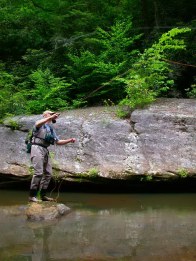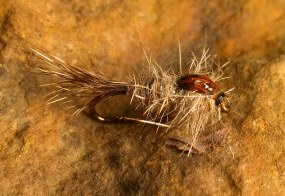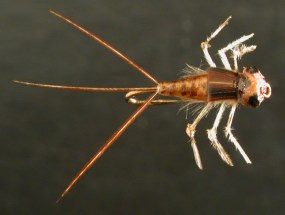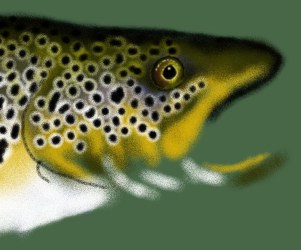Invicta Flies - The Art of Imitation
 |
When one looks at the products of such gifted fly tiers as Carrie Stevens, Ronn Lucas Sr., or Thomas Duncan Sr., he has little doubt that crafting such beauty onto a steel hook is an art form. Rich colors, balance and proportion, aesthetic value, and meaningful names are just some of the properties of these flies that obviously place them in a category shared by paintings, sculptures, drawings, and so forth.
But the comparison does not stop there. What of the common Hare's Ear or Pheasant Tail nymphs? The classic dries of the Catskills? Or the flies that find a niche in the boxes of one innovative tier who has developed them, yet not given them names? Do the tiers of such flies consider themselves artists? They may, or, they may not. I believe they should. Or at least understand the similarities.
|
An art mentor once told me that drawing is eighty percent observation. If you sat down to draw a picture of my tying desk, could you do it? You might guess at it or speculate on what goes where and such, but how accurate would the drawing be? Not very, most likely. What about something you know very well, your favorite fly reel, for instance? You could get pretty close, but what of the shadows, the depth, the pespective, or the subtle variations of tone within each color? Did you remember the scratch on the rim, put there when you dropped it on the mad scramble over the waterfall to your favorite pool during a Cahill hatch? In fly tying, the observation factor is much more considerable. You strive to not only copy local insects in size, proportion, and color, but in movement and behavior as well. You are, in a sense, creating a moving sculpture.
Jackson Pollack, Pablo Picasso, Claude Monet... how do abstract artists and impressionists such as these correspond to a "regular" fellow just trying to catch some fish? Color, balance, impression, portraying a "mood." The Deer Hair Diver, Stimulator, Light Spruce... hold these up and look at them. What do they look like? Nothing really. But the impression is there. Placed in an environment where such things are possible they become struggling baitfish, hatching stoneflies, or fleeing darters. Color to attract, portray a mood, or mimic life; balance and composition to allow it to "act" in a natural manner. Combining all these elements gives the fish an "impression" of something it might like to eat.
Before I loose you and you think I'm just spewing forth opinion, consider this:
Unless you are a professional fine artist, you spend most of your week in a career that focuses on the analytical, logical, left side of the brain. You're tied up in knots by the week's end, probably, so when the weekend comes, it's off the stream. Or after a long day, an hour or so at the tying bench helps you unwind. Why? Partly because you're doing what you want to do, but mostly because you've switched brain sides. You visualize, create, allowing the right side of the brain to automatically draw correlations and perspectives. You move toward balancing out your mental processes. The chart at the right is from the Betty Edwards' book "Drawing on the Artist Within." Here, she illustrates some functions associated with each side of the brain. She also points out that these functions "...may vary considerably in the brain hemispheres of specific individuals..." From person to person, there may be some cross-over, but for the most part, fly tying and fishing involve activities and mental functions associated with the right side of the brain.
|
|
Slightly confusing? Here's an example: You get to the stream and see that the Green Drakes have just started coming off the water. Checking your box you scan your flies for a match. You're using your right-sided thinking to visualize the closest representation. The fly is tied on and a fine trout is feeding on the surface nearby. Do you measure the distance? Calculate the velocity and angle of the cast? Dig out the calculator and punch in numbers to figure the drift based on a numerical representation of the flow? Of course not. You make the cast and just do it. In a mere moment. The right side of the brain does this.
 |
You might want to argue with me here. Don't you calculate the drift? Concentrate on the angle of the cast? Compare the natural to the fly you tied on? Certainly. But there are no figure-crunching measurements. Even holding the natural against the artificial to measure for size is a right-brain function... the brain makes the correlation between the two. You didn't measure each and compare the numbers, which is a left-brain function.
This concept of left- and right-brain function is hard to understand, and even harder to put into words. If nothing else, keep this in mind: the artist visualizes the finished product, the fly fisher and tyer visualizes constantly, in tying the flies, "picturing" where a good trout may lie, visualizing the drift and the take.
Don't get me wrong, the other side of the brain is not sleeping. The two sides work together, with one being dominant in different situations. The right side is elusive and often in the background. Bring that out and balance is acheived, to the refreshment of your soul.
|
Any art student will tell you that one of the best ways to improve your skills is to copy the masters. You draw their drawings, paint their paintings, understand the techniques they use and the theories they employ. It is the same in fly tying. Most often, the first flies tied are proven, classic patterns. These are in a book, or you know they are effective and thus have chosen these as a starting point. It doesn't take long, though, before you set out on your own, making substitutions, even designing your own patterns based on your own style or observations. An art student can study Degas for years, but still has his own style. While the techniques may be similar, the process is based upon personal interpretation and "feel." To illustrate this, look at the same fly tied by several different people. Materials can be exactly the same, even the size. But each one is unique. Each has the personal touch of the one who tied it. I could tie Matuka Sculpins until the end of my days, and yet they still won't look like Dave Whitlock tied them. Is that because I have failed in improving my skills? Well, that's possible, but mostly it's because Dave has a certain tying style, and I have a different style.
To be a good artist, a good understanding of the medium is essential. You need to know the ins and outs of oil paints to effectively produce an oil painting. You could create a nice drawing with any ol' pencil, but it would be further enhanced if you had an understanding of paper texture, 2H or 4B hardness, graphite, charcoal softenss, shading techniques. So, too, with fly tying... the more working knowledge you have of different materials, the better you will be able to imitate natural food sources.
As you use materials, you become familiar with how they look, how best to attach them to the shank, and how they act as they're being fished. You build a mental catalog of all your materials, and soon, you pick up a light cahill nymph and realize, "Hey, pheasant tail fibers are perfect for the tail, empbroidery thread will easily create those dark edges on the segments, and a spikey blend of bobcat mask dubbing has the sme markings and can be picked out well enough to provide flailing legs." These materials are your medium. Get to know them, and your tying skills are limitless.
|
 |
So do the most realistic flies indicate a better fly tier as an artist? Some of the most revered masters of fine arts produced paintings that are far from photo-realistic. The status of the artist is dependent on whether or not the desired effect has been acheived and popular approval of the intended audience. Super-realistic flies can be machine made from materials like plastics, resin, and acrylics. We don't see these around, because they don't work. Only one element, that of appearance, has been considered. Your standing as an artist in the field of fly-tying depends on how well your work acheives your goal... you catch fish on your flies. Included in this are all the other aspects of fly-fishing, such as presentation and knowledge. The whole field of fly fishing is, in fact, an art.
 |
The purpose of all this is get you to perhaps look at your fly tying in a slightly different manner... that is, as an art form. Understanding this and the parallels between mediums will allow you to approach tying not as a technical skill, but a creative process, drawing on your own experiences and techniques to achieve your own goals. If you are unfamiliar with art, I recommend doing some light sketching (you don't have to show anybody, of course, so just go for it). This can be as simple as a rough draft to record relevant information on insects you've seen streamside, or as complex as rendering a scene of a recent outing. Browsing through some art books as well as checking out the artwork of fly tyers like Dave Whitlock and Jason Borger, can
|
also help you get into the artistic mindset. Getting to know things like the "color wheel" and fundamentals of perspective, balance, and proportion can bring a whole new dimension to your flies.
* Betty Edwards. Drawing on the Artist Within. New York, NY, Simon & Schuster, Inc., 1986.
 Detail of a work in progress: Cumberland Brown Trout
by Rob Knisely
|